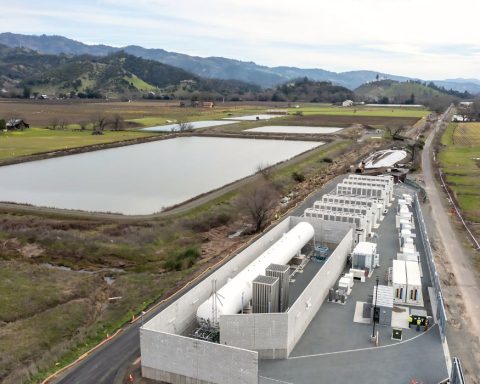I was in New York City doing a photo shoot for Corporate Knights when news broke that a duo of University of Calgary researchers had come up with a new, very inexpensive catalyst — i.e. rust — for generating hydrogen gas from water. Can’t believe I missed it, actually, because it received wide coverage — from MIT Technology Review to Canada’s Globe and Mail and CBC Online. Still, for those like me who missed it, here’s a quick rundown of why this is potentially important and what it means for the so-called hydrogen economy. I have no doubt that this has caught the attention of many big-name players in the hydrogen and broader energy sector since the research was published online in the journal Science.
According to the press release out of FireWater Fuel, the company spun out of this research, what has been discovered is a “breakthrough method of fabricating electrocatalysts made of inexpensive, non-toxic, and abundant resources, that facilitate the production of clean hydrogen from water.” An electrocatalyst, I should say, is simply a material that causes a chemical reaction to take place when an electrical current is introduced. Conventional catalysts used to split water into hydrogen and oxygen come from rare and expensive metals such as platinum, which costs more than $1,700 an ounce and is highly volatile price-wise. Pre-2008, it had reached over $2,000 per ounce. I remember a conversation I had with Ballard Power president John Sheridan back then. When the recession hit and platinum prices plunged to $800, Sheridan said Ballard locked in a large order knowing full well the price would rise again — and it has. Platinum prices matter to fuel cell developers. When they’re high, they can represent up to one-third of the total cost of a proton-exchange membrane fuel cell. Water electrolysis units used to produce hydrogen are basically fuel cells that operate in reverse, meaning they also rely greatly on platinum.
(It should be said that platinum also plays a big role with internal combustion engine vehicles, as every catalytic converter in a vehicle (required by law) contains platinum. However, ICE vehicles generally contain less than one-tenth the amount of platinum as a fuel cell-powered vehicle.)
The need to eliminate our dependency on expensive platinum and other rare-earth metals is why the U of C breakthrough is potentially game-changing. If you can eliminate the need for platinum and replace it with a less exotic, more abundant and — most importantly — dramatically cheaper catalyst, then the dream of using hydrogen as an energy storage medium becomes that much more real. Indeed, FireWater Fuel claims it can make a competitive catalyst from “Earth-adundant” materials such as iron oxide — i.e. rust. We certainly have a lot of rust, so that’s promising. Cobalt and nickel are other plentiful compound metals that are used. Essentially, the researchers use light at low temperatures to produce mixed metal-oxide films for the electrodes that are used in the electrolysis process. FireWater says its second-generation prototype “already outperforms the industry benchmark despite costing only a fraction of the price and consisting of environmentally benign materials.” By “fraction” they mean nearly 1,000 times cheaper. So far, the approach is more than 85 per cent efficient and the company is working to have its first commercial electrolyzer on the market by 2014, with a small home-scale unit possible by 2015.
The commercial units could, for example, be used to economically produce hydrogen from surplus, low-cost electricity (such as overnight wind energy production). That hydrogen could then be stored and used later to generate electricity (via fuel cell or combustion turbine) when the power is most needed, thereby smoothing out the variability of wind. It could also be paired with an off-grid wind farm in a remote area that wants to wean itself from diesel back-up generators. At home, a smaller unit could be used to produce hydrogen on demand from rooftop solar panels. If this becomes economical, it may remove a major barrier that has prevented fuel-cell vehicles from entering the market.
Perhaps. May. Could. Potentially. This would all be VERY cool if it came to fruition, but having reported on past announcements like this I will wait for more evidence of progress. This has to be proven at a scaled-up level, and there will certainly be many speed bumps and funding challenges along the way to commercialization. It’s also worth noting that this research isn’t entirely unique. There are many start-ups and research teams out there making breakthroughs in alternative catalysts for hydrogen production. Just type in “cheap + catalyst + hydrogen” in Google and you’ll see what I mean. One particular company, Georgia-based GridShift, claims it has developed a catalyst that uses no rare-earth materials and reduces catalyst costs by 97 per cent — i.e. catalysts at $60 an ounce versus $1,700 for platinum.
Back in 2010, when it emerged out of stealth mode, GridShift said it could produce hydrogen at a cost of $2.51 per kilogram, “effectively making hydrogen a more affordable alternative than gasoline at an equivalent cost of $2.70 per gallon of gasoline.” According to the company, “GridShift’s new method for hydrogen generation produces four times more hydrogen per electrode surface area than what is currently reported for commercial units today. This means that an electrolysis unit using the GridShift method would produce at least four times more fuel in the same-sized machine, or require a unit four times smaller than normal to make the same amount of hydrogen.” Three years later, there’s not much word from GridShift, even though it is backed by venture capitalist Vinod Khosla. Still, founder Robert Dopp keeps putting out studies.
So in a nutshell, I’m very excited about this University of Calgary research and hope FireWater Fuels can get to a finish line that others have so far failed to reach. It would truly put hydrogen back in the running as an energy storage medium for renewables and fuel-cell vehicles, with the added irony that it would originate from Calgary — the financial heartland of Canada’s oil sands industry.







